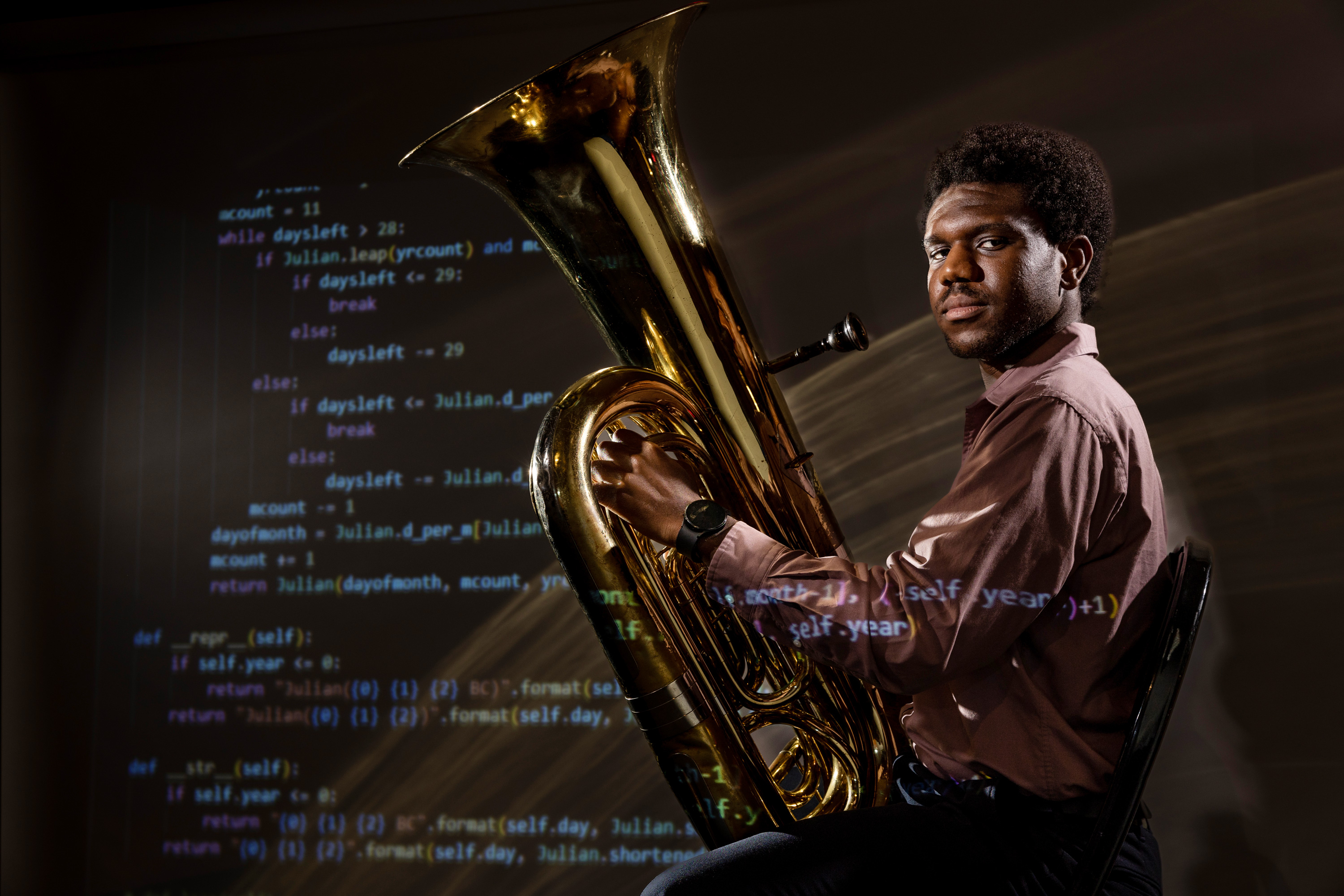

How does a band play music together when they are so far apart? This was the question facing Frederic Agisafi and the rest of the MIT Wind Ensemble at the start of the COVID-19 pandemic. One method was to individually record tracks that were later mixed together to sound like a complete collection.
“It was a strange experience,” says Ajisafe, who plays the tuba and is pursuing a double major in aerospace engineering and music. “It wasn’t as cohesive as playing together in person, but the results are something to be proud of.”
Now that the group is able to train in person again, Ajisafe has a renewed appreciation for the community he found within MITWE.
“In terms of uniting the group, the intangible and social bonds that we all have, I feel like we’re back in that sense,” he says. “The biggest difference is that I’m a senior. The last time we were together without masks, I was a freshman looking for people, but now people are looking at me.”
Ajisafe was an accomplished musician who had been playing the tuba since middle school.
“In middle school, I heard a lot of things like ‘Music makes you smarter,’ and I was like, ‘Well, I want to be smarter,’ so I joined the band program,” says Ajisafe. “Something about the shape of my lips and the capacity of my lungs was really good for my tuba.”
It was more than just a physical affinity for the instrument that kept Ajisafe playing; I also love the social aspect of playing in a band. Last year, he was accepted as an Emerson Scholar in tuba performance, and took subsidized private lessons with renowned professional tuba player Ken Ames.
Ajisafe has also taken a variety of classes at MIT’s Department of Music and Theater Arts covering a wide range of subjects, from traditional theory to composition.
One of his favorite classes is 21M.361 (Electronic Music Composition), which teaches how to sample and process sounds in various programs. Some of the sounds sampled from Ajisafe over the course of the semester include snapping, clapping, scale playing on its trumpet, and hitting something on the floor. Then, these sounds were appropriate to the score Ajisafe had created for a previous task. He described the process as intellectually satisfying, as well as pushing boundaries in how he understood music.
“Most people probably wouldn’t call it music, but it does have musical elements,” says Ajisafe. “It gives you a new perspective on the world.”
From spelling bees to natural language processing
Growing up in Orlando, Florida, Ajisafe had a wide range of interests growing up.
“Whatever they were doing in school, I was excited about it,” he says. “I was always interested in words and things like that, but I was also interested in science and math.”
Growing up near NASA’s Kennedy Space Center, it’s easy to see how Ajisafe fostered an interest in space.
“Aerospace engineering is the most exciting field of engineering right now,” says Ajisafe. “And you can see it with all the things that happen in Florida. Seeing all the rocket launches inspired me to choose Aeronautical Engineering and once I got into it, I emphasized it more and more.”
But there was also a childhood involvement in the local spelling bee that sparked his interest in words. Now, he’s working on a project, through MIT’s Undergraduate Research Opportunities Program, that brings together linguistics, natural language processing, and aircraft design requirements.
One of the challenges of writing aircraft design requirements is ambiguity, especially when the requirements are written in a traditional, natural language form. More engineers are turning to model-based systems architecture standards, which are newer and more formal. Ajisafe addresses the problem of translating the original requirements into the newer form, specifically, collecting representative training data for a machine learning algorithm.
“I’m figuring out the most subtle level of naming these types of sentences to see if we can use a more automatic system using parts of speech,” explains Ajisafe. “For example, perhaps you could devise a pattern naming a noun at the beginning of a sentence as the entity of interest to systems engineers, such as ‘The parachute will deploy at this time’—the parachute is the entity.”
Instead of turning every detail of the sentence into a system model, his team decided it was more effective to focus on labeling and extracting certain key elements.
The project brings together the many different skills Ajisafe has acquired throughout his career at MIT, all coming together in harmony to tackle a unique problem.
“I always want to see the next thing next.”
Next year, Ajisafe plans to pursue a master’s degree with the Department of Aeronautics and Astronautics.
“Ultimately, I would like to work with technical problems related to space exploration and getting humanity to the stars,” says Ajisafe. “I don’t know exactly where I fit in that, but I hope it makes a positive impact.”
And of course, as has been the case all his life, he wants to continue playing music, whether it’s playing trumpet or trying other outlets.
“For humanity to survive,” Ajisafe says regarding his career aspirations, “it is good and perhaps even necessary to look for other places besides Earth.” But he also relates to how he handles his personal life: “I always want to get out of a place I’ve never been and be somewhere I’ve never been quite familiar with. I always want to see the next thing after that.”
